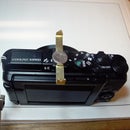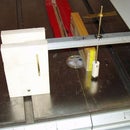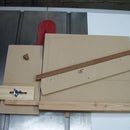Introduction: Small Cheap Check Valves for Tubing
I needed some small, compact, simple check valves for an engine project, so built a couple types which, with minor modifications, should work well for most fluids.
Step 1: Type I: Brass Tubing Fittings, Ball Bearing and Spring (untested!)
Parts (shown in photo):
- Coupling, brass, 1/8" x 1/8" (pipe thread), one required
- Connector, brass, 1/4" (copper tubing) x 1/8" (pipe thread), two required
- Ball bearing, 1/4"
- Small spring (optional, see Type II)
I bought all the parts at my local Ace Hardware, everything is commonly available except maybe the ball bearing balls.
You can visualize how this works from the photo. With the parts assembled, the spring holds the ball against the inside opening of the connector, preventing flow in that direction; to the left in photo. However, fluid pressure in the other direction will compress the spring and allow flow.
The parts shown are for 1/4" copper tubing, using compression fittings. Using the basic concept (internal ball check), a similar check valve could be made for larger copper tubing. You could also substitute hose fittings for the tubing connectors.
You would use this design if you felt you needed an internal spring to make a positive, tight shut off. But think about this:
- The spring will create back pressure, which you may not want.
- You will have to shop around to find just the right spring to fit inside the coupling.
- Some drilling or grinding may be necessary to allow the spring and ball to fit inside the coupling.
Now that I have said all that, the next step will describe a similar check valve but without the spring.
Step 2: Type II: Brass Tubing Fittings and Ball Bearing
I thought a check valve would need a spring, but after some experimenting decided that a spring might not be necessary, at least for my project.
Parts (shown in photo):
- Coupling, brass 1/8" x 1/8" (pipe thread) , one required
- Connector, brass, 1/4" (copper tubing) x 1/8" (pipe thread) two required
- Ball bearing, 1/4"
This is the same as the first, with two changes:
- No spring
- A crosscut was made in the inside end of one coupling.
I found that fluid flow and pressure will seat the ball without the spring.
The crosscut in the internal face of one connector (actually two cuts, like an "X"), allows fluid to flow past the ball in one direction, fluid flow in the other direction will seat the ball, stopping flow.
I completed and tested Type II and it worked very well without the spring. However, if you have to have absolute tight shutoff under all conditions, consider Type I .
Step 3: Type III
This is the cheapest and most simple. It is just a ball bearing in the tube.
Pressure in the tube will seat the ball against the opening in the tee (or other fitting), stopping flow. Pressure from the other way will drive the ball against a short piece of copper tubing inserted tightly into the tube. The copper tube piece has grooves cut into the face which allow flow.
These pieces are all 1/4" components, with a 3/16" ball.
The photo is just to show the concept, for pressure applications a pressure hose and hose clamp would be used.
This one may be a little strange, but I plan to use it because it is so small and simple that it will take up no additional space.




